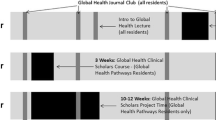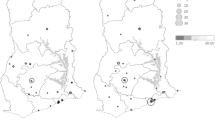Abstract
Surgery is increasingly recognized as an effective means of treating a proportion of the global burden of disease, especially in resource-limited countries. Often non-physicians, such as nurses, provide the majority of anesthesia; however, their training and formal supervision is often of low priority or even non-existent. To increase the number of safe anesthesia providers in Haiti, Médecins Sans Frontières has trained nurse anesthetists (NAs) for over 10 years. This article describes the challenges, outcomes, and future directions of this training program. From 1998 to 2008, 24 students graduated. Nineteen (79%) continue to work as NAs in Haiti and 5 (21%) have emigrated. In 2008, NAs were critical in providing anesthesia during a post-hurricane emergency where they performed 330 procedures. Mortality was 0.3% and not associated with lack of anesthesiologist supervision. The completion rate of this training program was high and the majority of graduates continue to work as nurse anesthetists in Haiti. Successful training requires a setting with a sufficient volume and diversity of operations, appropriate anesthesia equipment, a structured and comprehensive training program, and recognition of the training program by the national ministry of health and relevant professional bodies. Preliminary outcomes support findings elsewhere that NAs can be a safe and effective alternative where anesthesiologists are scarce. Training non-physician anesthetists is a feasible and important way to scale up surgical services resource limited settings.
Similar content being viewed by others
References
Weiser TG, Regenbogen SE, Thompson KD et al (2008) An estimation of the global volume of surgery: a modelling strategy based on available data. Lancet 372:139–144
Hansen D, Gausi SC, Merikebu M (2000) Anaesthesia in Malawi: complications and deaths. Trop Doct 30:146–149
Ouro-Bang’na Maman AF, Tomta K, Ahouangbevi S et al (2005) Deaths associated with anaesthesia in Togo, West Africa. Trop Doct 35:220–222
Walker IA, Wilson IH (2008) Anaesthesia in developing countries—a risk for patients. Lancet 371:968–969
Cherian MN, Noel L, Buyanjargal Y et al (2004) Essential emergency surgical procedures in resource-limited facilities: a WHO workshop in Mongolia. World Hosp Health Serv 40:24–29
Adnet P, Diallo A, Sanou J et al (1999) [Anesthesia practice by nurse anesthetists in French speaking sub-Saharan Africa]. Ann Fr Anesth Reanim 18:636–641
Lokossou T, Zoumenou E, Secka G et al (2007) Anesthesia in French-speaking sub-Saharan Africa: an overview. Acta Anaesthesiol Belg 58:197–209
Walker I, Wilson I, Bogod D (2007) Anaesthesia in developing countries. Anaesthesia 62(Suppl 1):2–3
Chu K, Rosseel P, Gielis P et al (2009) Surgical task shifting in sub-Saharan Africa. PLoS Med 6:e1000078
Mullan F, Frehywot S (2007) Non-physician clinicians in 47 sub-Saharan African countries. Lancet 370:2158–2163
Ozgediz D, Galukande M, Mabweijano J et al (2008) The neglect of the global surgical workforce: experience and evidence from Uganda. World J Surg 32:1208–1215
Grundy BL, Medsger A, Silverman M et al (1987) Characteristics of nurse anesthetists working with and without anesthesiologists. Med Care 25:1129–1138
Torgersen KA, Chamings PA (1994) Examining collaborative relationships between anesthesiologists and certified registered nurse anesthetists in nurse anesthesia educational programs. AANA J 62:139–148
Abenstein JP, Warner MA (1996) Anesthesia providers, patient outcomes, and costs. Anesth Analg 82:1273–1283
Simonson DC, Ahern MM, Hendryx MS (2007) Anesthesia staffing and anesthetic complications during cesarean delivery: a retrospective analysis. Nurs Res 56:9–17
Smith AF, Kane M, Milne R (2004) Comparative effectiveness and safety of physician and nurse anaesthetists: a narrative systematic review. Br J Anaesth 93:540–545
Hodges SC, Mijumbi C, Okello M et al (2007) Anaesthesia services in developing countries: defining the problems. Anaesthesia 62:4–11
McAuliffe MS, Henry B (2000) Nurse anesthesia practice and research—a worldwide need. CRNA 11:89–98
Jochberger S, Ismailova F, Lederer W et al (2008) Anesthesia and its allied disciplines in the developing world: a nationwide survey of the Republic of Zambia. Anesth Analg 106:942–948 table of contents
Organization PAH (2007) Health situation in the Americas: basic indicators 2007. Organization PAH, Washington, DC
Chatterjee P (2008) Haiti’s forgotten emergency. Lancet 372:615–618
WHO (2006) World health report: 2006. Working together for health. World Health Organization, Geneva
Farmer PE, Kim JY (2008) Surgery and global health: a view from beyond the OR. World J Surg 32:533–536
Mullan F (2005) The metrics of the physician brain drain. N Engl J Med 353:1810–1818
Ivers LC, Garfein ES, Augustin J et al (2008) Increasing access to surgical services for the poor in rural Haiti: surgery as a public good for public health. World J Surg 32:537–542
Tweed WA, Amatya R, Tuladhar TM et al (1993) Anaesthesia services and the education of anaesthetists in Nepal: a model for sustainable development? Can J Anaesth 40:993–999
Zimmerman M, Lee M, Retnaraj S (2008) Non-doctor anaesthesia in Nepal: developing an essential cadre. Trop Doct 38:148–150
Philips M, Zachariah R, Venis S (2008) Task shifting for antiretroviral treatment delivery in sub-Saharan Africa: not a panacea. Lancet 371:682–684
Acknowledgments
The authors acknowledge the following NA trainers: Mathieu Simons, Pablo Nuozzi, Nadja Delaventure, Danielle Fleurent, Tupin Scrase, Ognian Grantcharski, Michael Casaer, Dominique Ostreicher, Fouad Harake, and Loris Defilippi.
Author information
Authors and Affiliations
Corresponding author
Rights and permissions
About this article
Cite this article
Rosseel, P., Trelles, M., Guilavogui, S. et al. Ten Years of Experience Training Non-Physician Anesthesia Providers in Haiti. World J Surg 34, 453–458 (2010). https://doi.org/10.1007/s00268-009-0192-2
Published:
Issue Date:
DOI: https://doi.org/10.1007/s00268-009-0192-2




